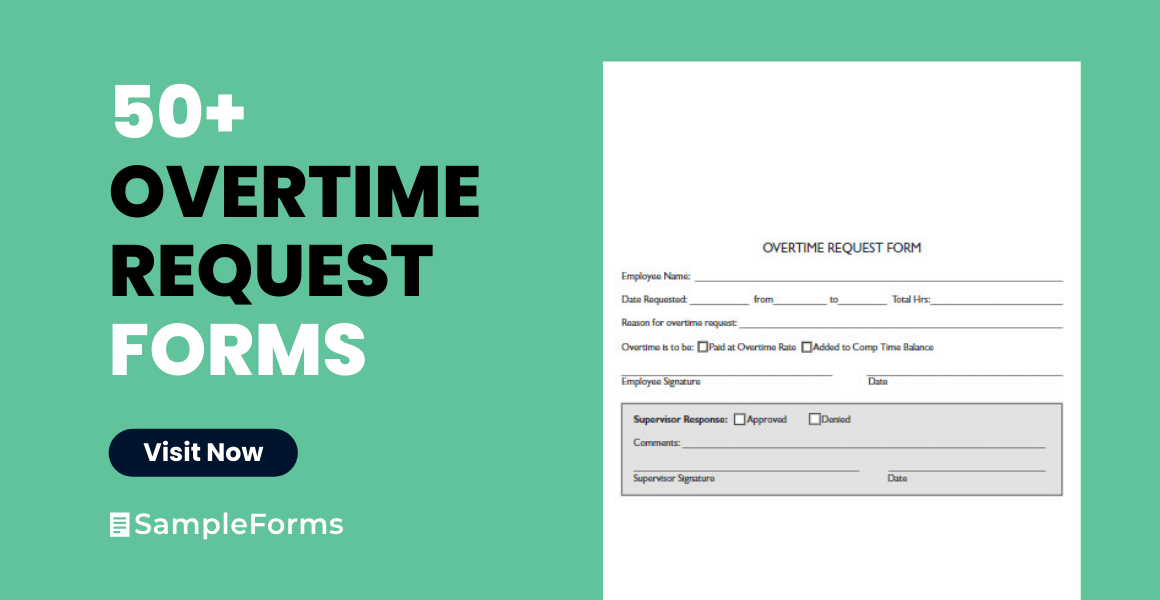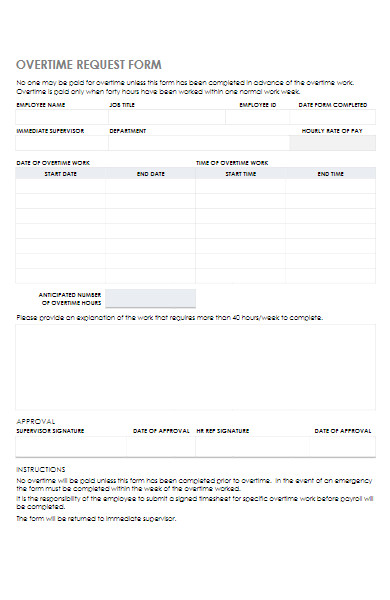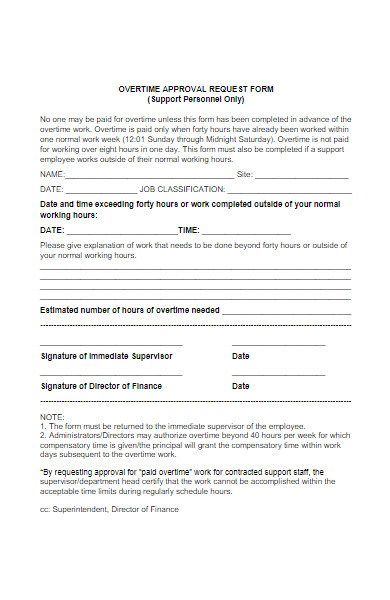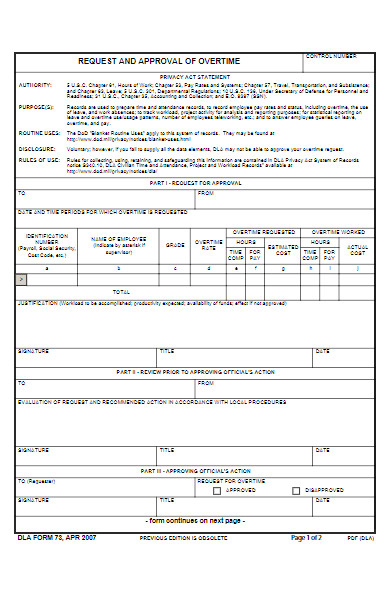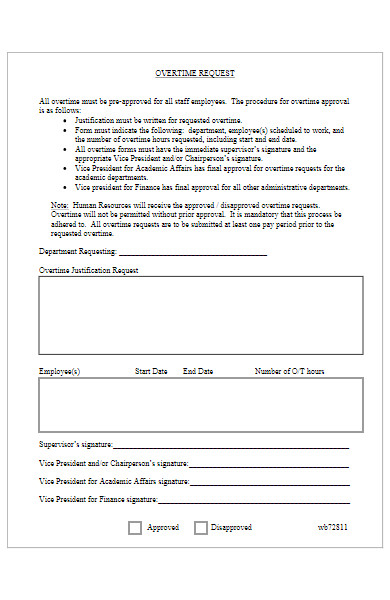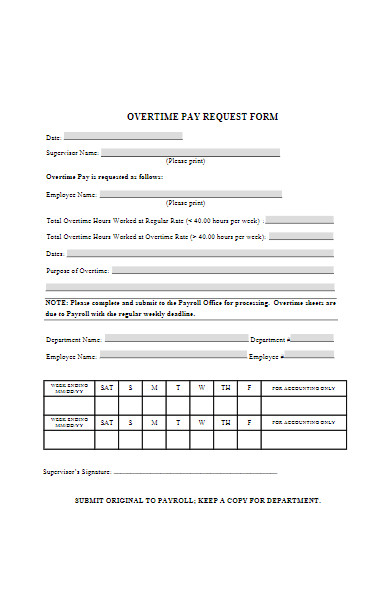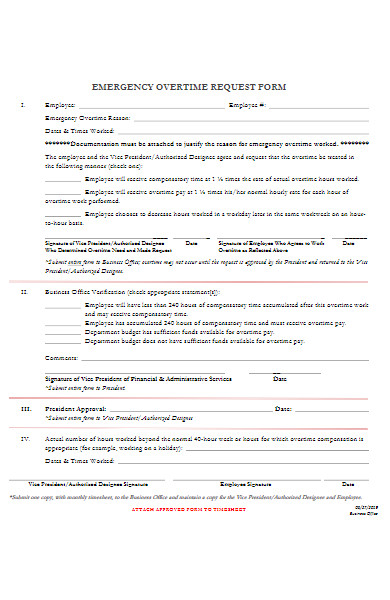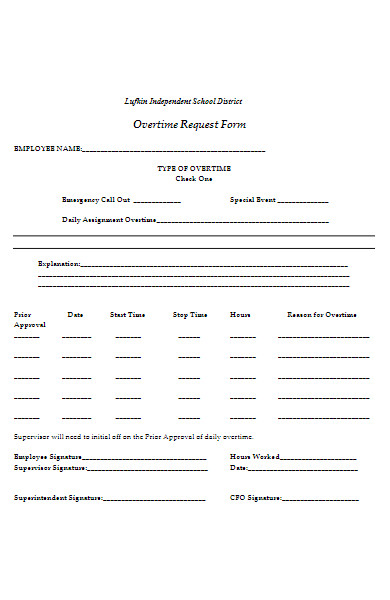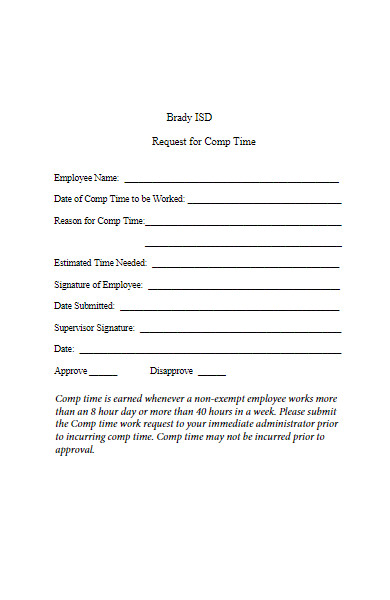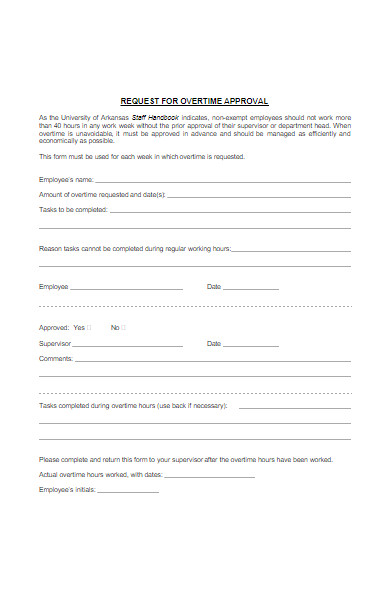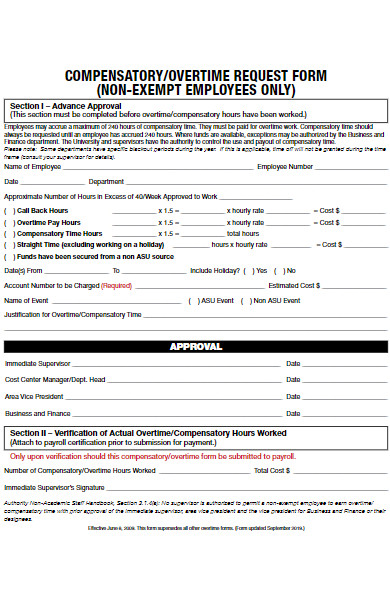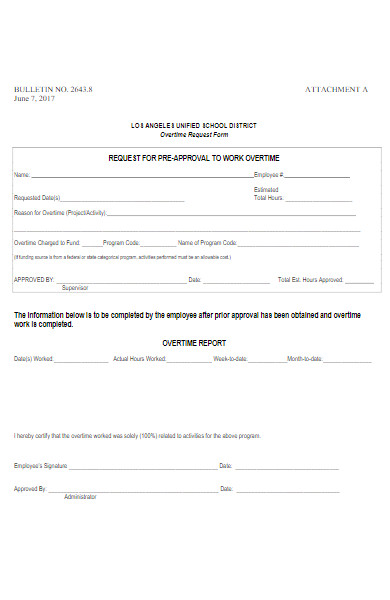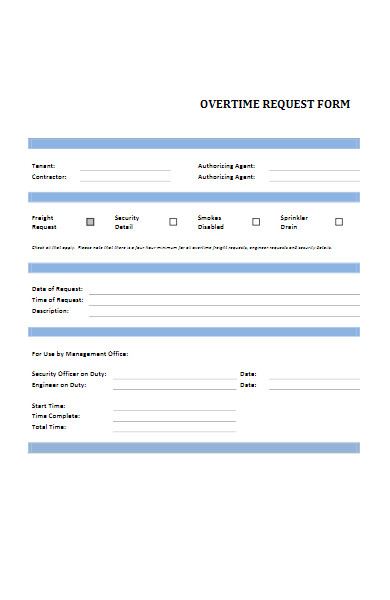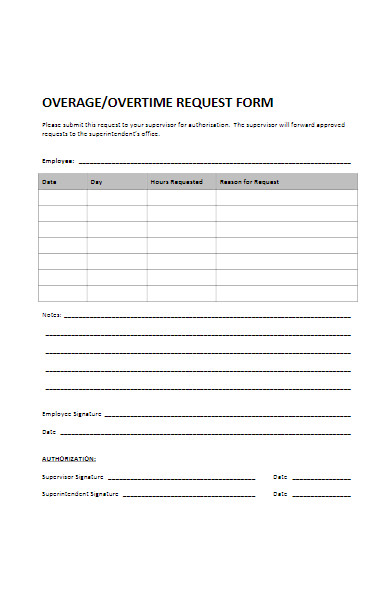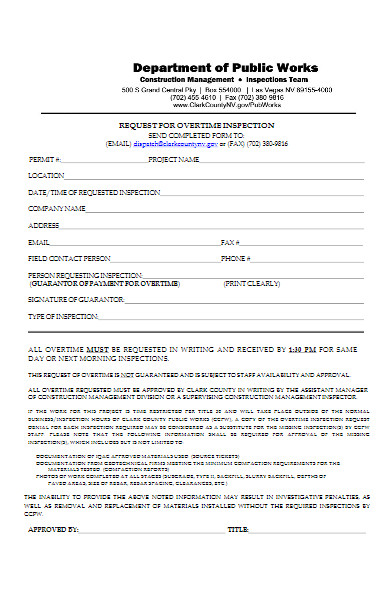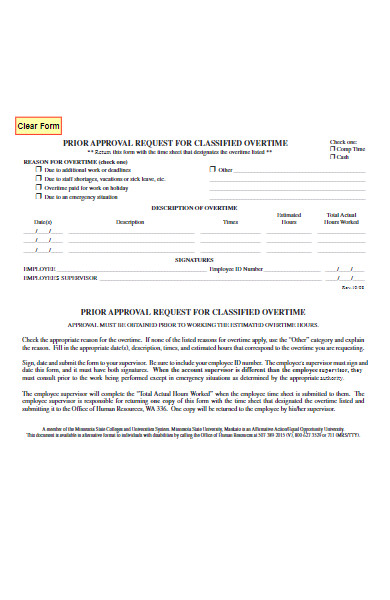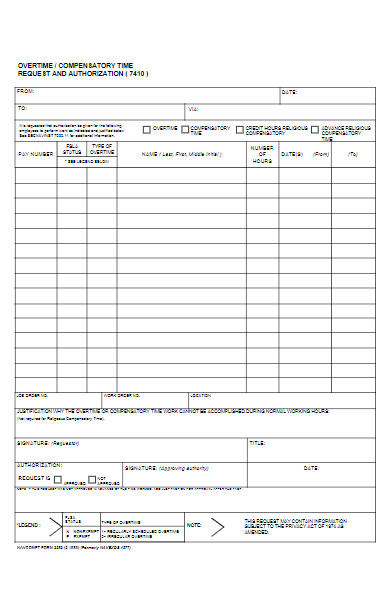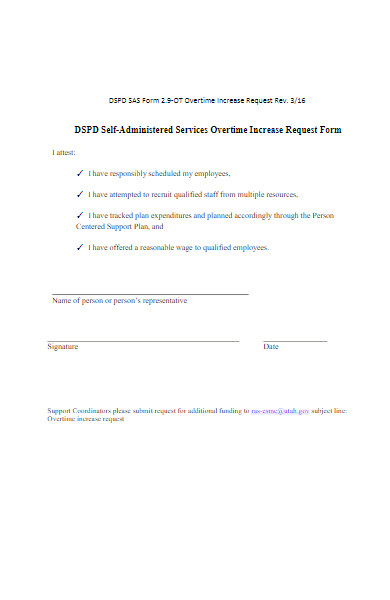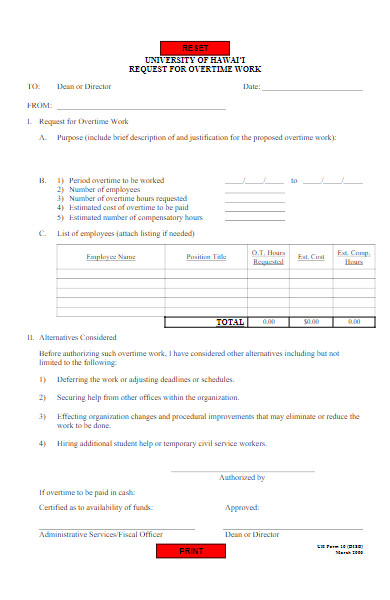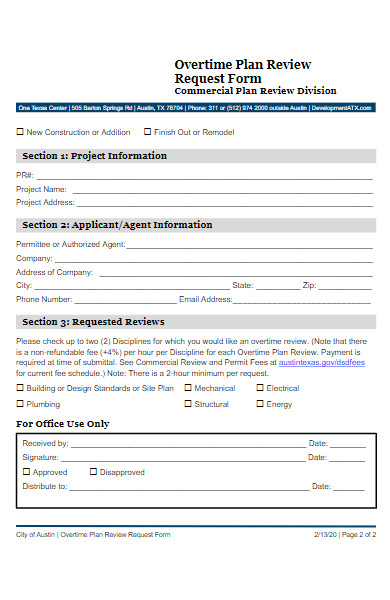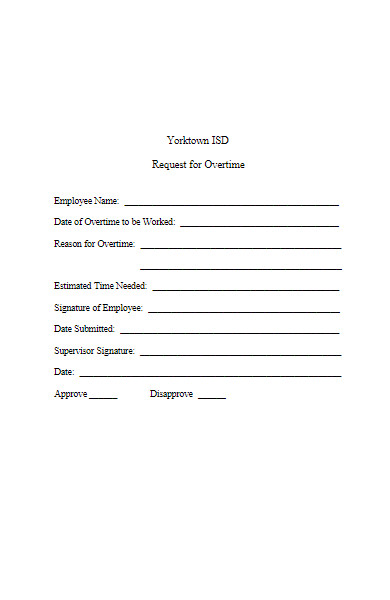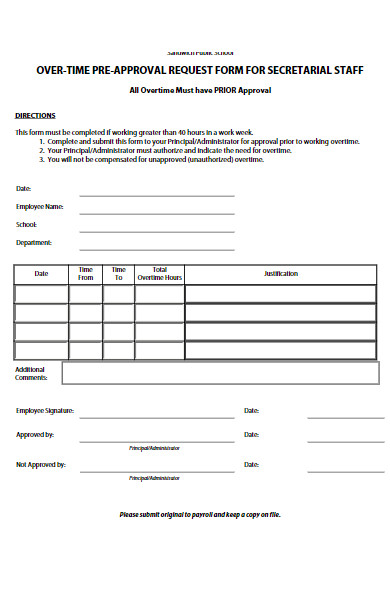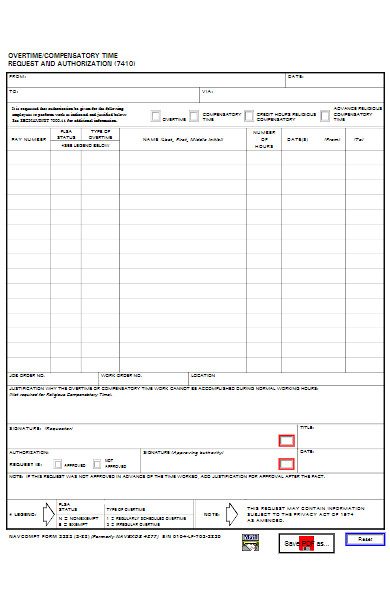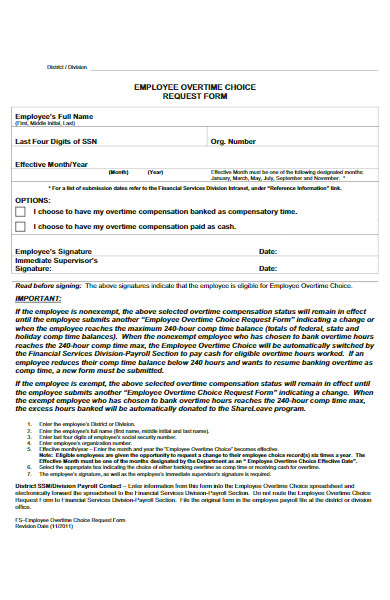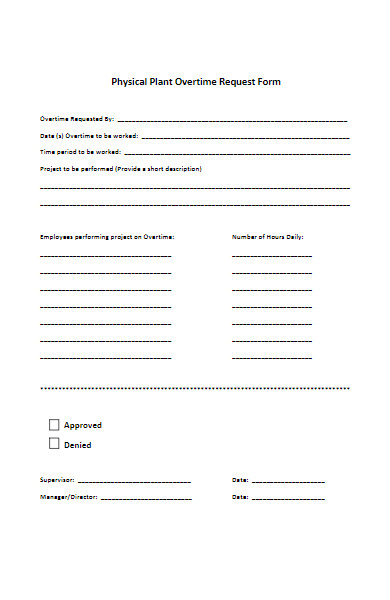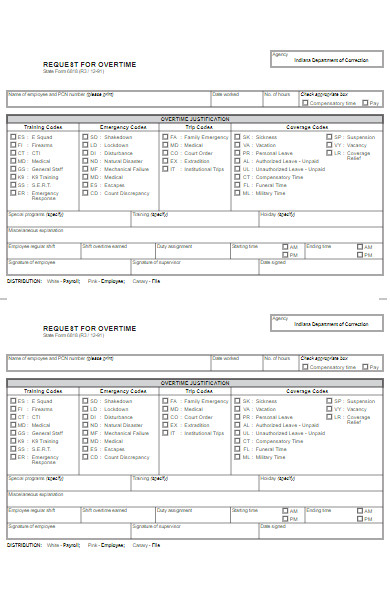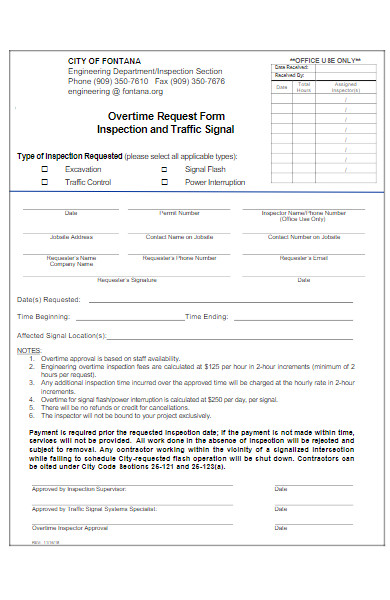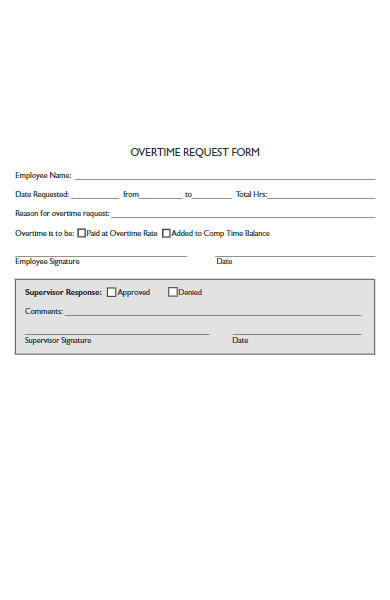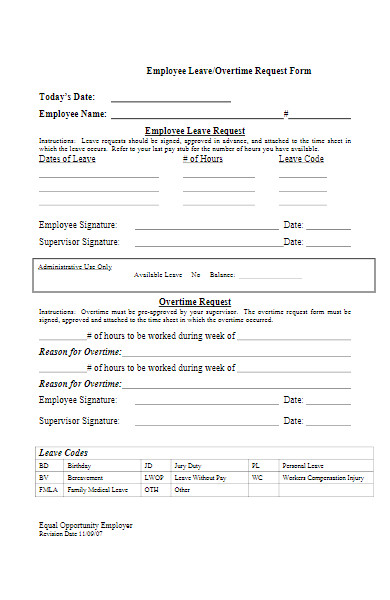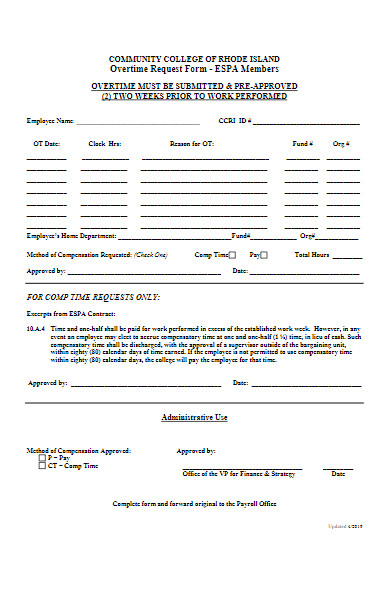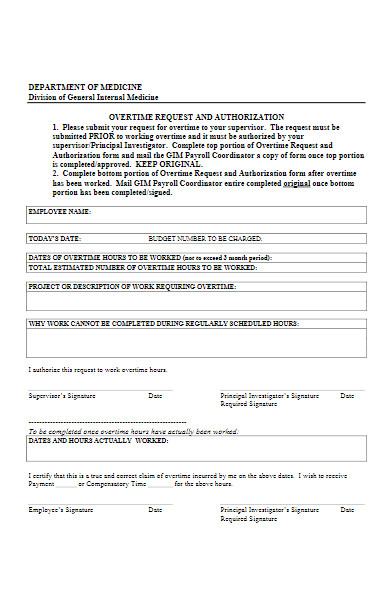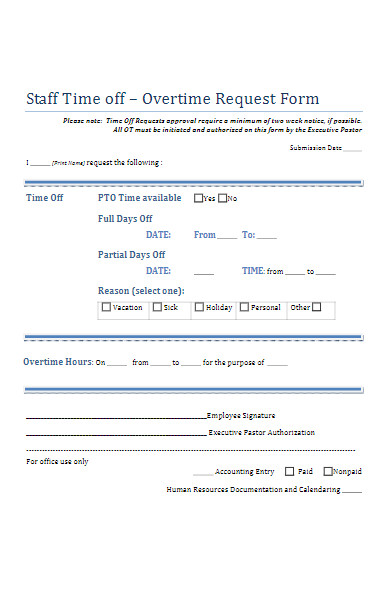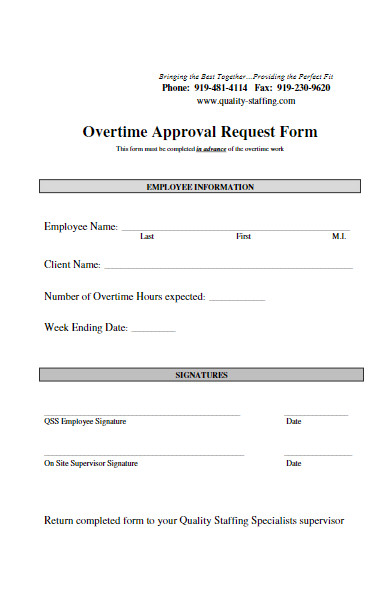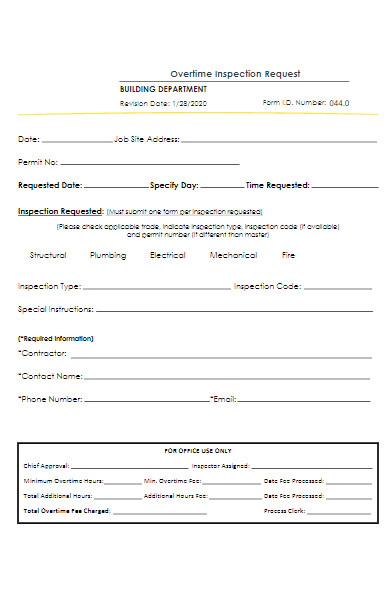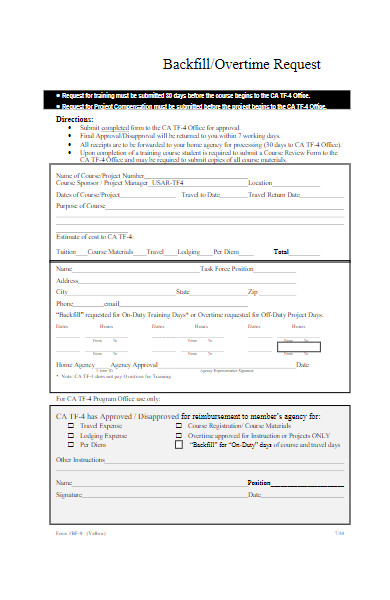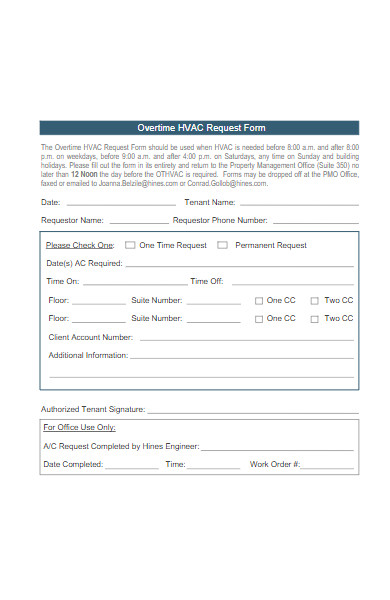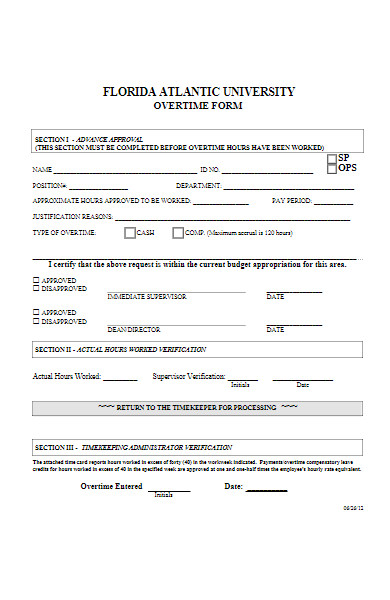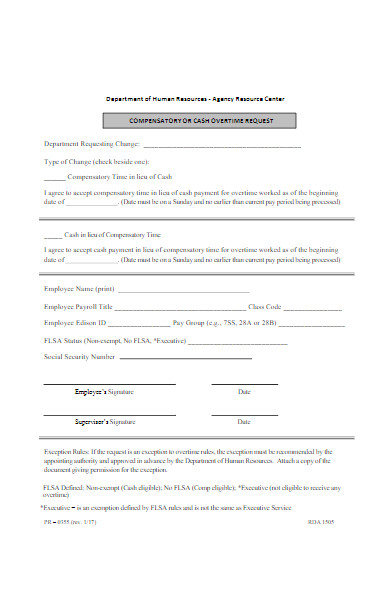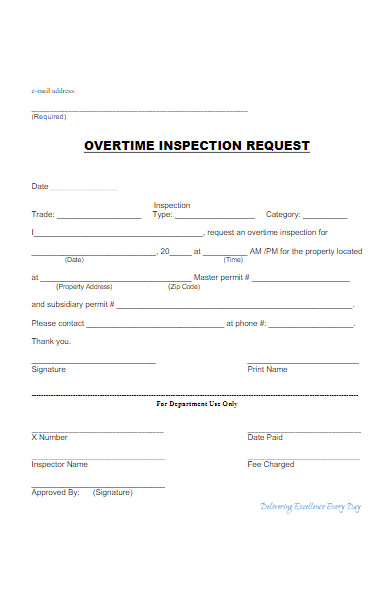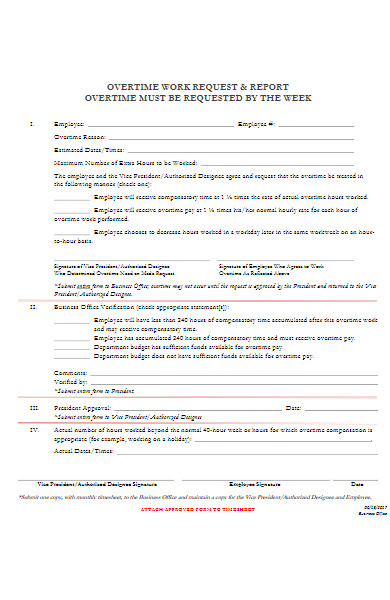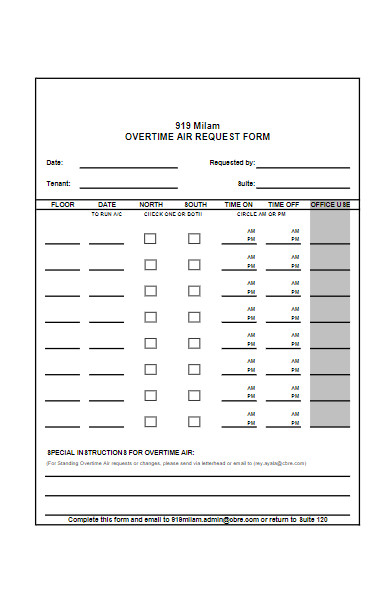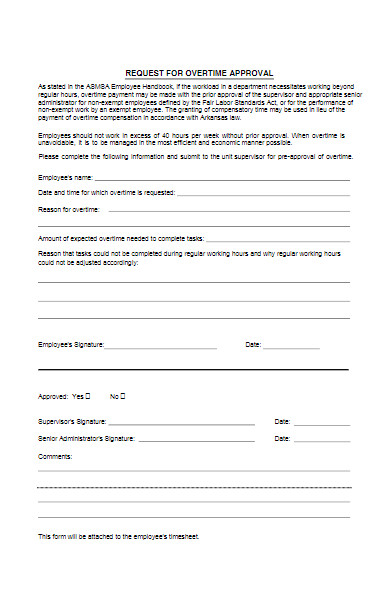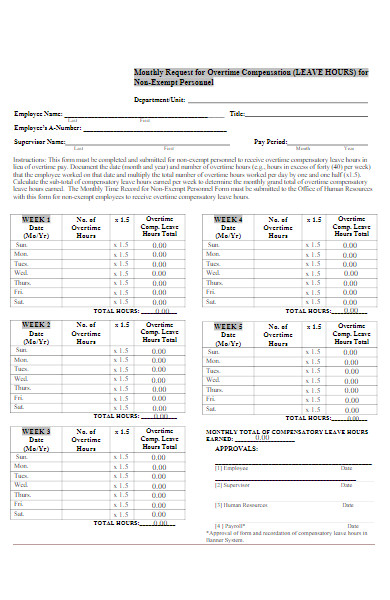In today’s fast-paced work environments, the demand for extra work hours is inevitable. An Overtime Request Form acts as a bridge between employees’ desires to put in additional hours and a company’s need to manage and approve these requests systematically. Whether you’re an employee seeking approval or a manager aiming for efficient staffing, understanding the meaning, types, and creation process of this form is essential. Dive into this guide to unravel its nuances and maximize its utility.
What is an Overtime Request Form ? – Definition
An Overtime Request Form is a formal document used by employees to request approval for working hours that exceed their regular scheduled hours. This form provides a structured way for employees to communicate their desire or need to work additional hours, allowing managers or HR departments to review, approve, or decline such requests based on operational needs, budget constraints, or labor laws. The form typically includes details like the employee’s name, the date of the requested overtime, the number of extra hours sought, and the reason for the request.
What is the Meaning of an Overtime Request Form?
The meaning of an Overtime Request Form extends beyond its basic definition. It symbolizes a structured communication channel between employees and management regarding additional work hours. The form not only facilitates an employee’s intent to work beyond regular hours but also aids organizations in tracking, managing, and ensuring proper compensation for such hours. By using this form, companies can maintain a balance between operational needs and employee welfare, while also ensuring adherence to labor laws and regulations concerning overtime. In essence, it promotes transparency, fairness, and systematic management of overtime work.
What is the Best Sample Overtime Request Form?
A comprehensive Overtime Request Form should capture all necessary details while being user-friendly. Below is a sample template:
Employee Details:
- Name: ________________________
- Employee ID: __________________
- Position/Title: ________________
- Department: ___________________
Overtime Details:
- Date of Overtime: ___ / ___ / ______
- Start Time: ________ End Time: ________
- Total Overtime Hours Requested: _______
Reason for Overtime: (Please provide a brief explanation for the need of overtime)
Supervisor/Manager Approval:
- Approved: [ ] Declined: [ ] (Please check the appropriate box)
Comments/Notes:
Signature of Employee: ____________________ Date: ___ / ___ / ______
Signature of Supervisor/Manager: ______________ Date: ___ / ___ / ______
Note: The actual format can vary based on the organization’s needs and the platform (paper-based or digital) used. Some forms might include additional fields such as project/task details associated with the overtime, hourly rate for overtime, or any applicable union guidelines. Ensure the sample request form aligns with your organization’s policies and local labor laws.
FREE 50+ Overtime Request Forms in PDF
51. Unscheduled Overtime Account Request Form
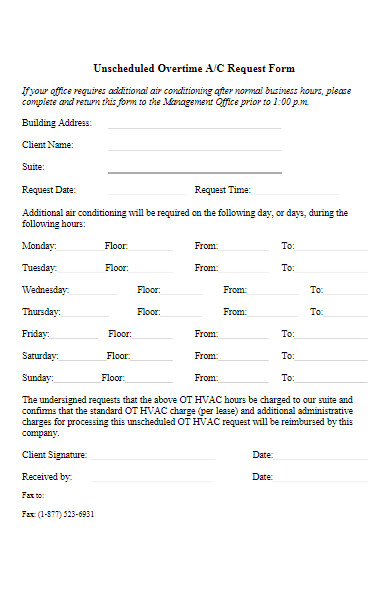
How do I fill out an Overtime Request Form properly?
Filling out an Overtime Request Form accurately is crucial, as it ensures you get the appropriate approval and subsequent compensation for the extra hours worked. Here’s a step-by-step guide to assist you:
-
Employee Details:
- Name: Clearly write your full name, as registered in the company records.
- Employee ID: Input your unique identification number, if applicable.
- Position/Title: Specify your job title or designation.
- Department: Mention the department you work in.
-
Overtime Details:
- Date of Overtime: Clearly mark the date when you wish to work overtime. If it spans multiple days, you might need to specify each date.
- Start and End Time: Indicate the exact hours you intend to start and finish your overtime. This helps in calculating the total hours.
- Total Overtime Hours Requested: Specify the total number of hours you expect to work as overtime. This is typically the difference between the end and start time.
-
Reason for Overtime:
- Be as specific as possible. Indicate why the overtime is necessary. It could be to meet a project deadline, cover for a colleague, or handle an unexpected workload.
-
Signature of Employee:
- Once you’ve filled out the form, review the information for accuracy. Then, sign and date the form. Your signature confirms the details you’ve provided are correct to the best of your knowledge.
-
Supervisor/Manager Approval:
- Leave this section blank, as it’s meant for your supervisor or manager. They will indicate approval or rejection and might include comments or notes for clarification.
-
Additional Notes or Comments (if applicable):
- Use this section if there’s any additional information that you believe would support your request or if there are specific details your supervisor should be aware of.
Additional Tips:
- Read Instructions: Some forms might come with specific instructions. Ensure you go through them before filling out the form.
- Use Black or Blue Ink: If you’re filling out a physical form, use blue or black ink for clarity.
- Avoid Overwriting: If you make a mistake on a paper form, it’s better to strike through the error neatly and write the correct information above or beside it. Alternatively, you can ask for a new form.
- Online Forms: If your company uses an electronic system or online portal, ensure that you save or submit the form after filling it out. Double-check all drop-down menus and fields for accuracy.
- Keep a Copy: Always keep a copy of the form for your records, whether it’s a physical photocopy or a digital snapshot.
Lastly, ensure you submit the form to the designated authority or department on time to avoid any delays or issues in processing.
How far in advance should I submit my Overtime Request Form?
The timeframe for submitting an Overtime Request Form can vary depending on company policy and the nature of the job. However, in general, the following guidelines may apply:
- Standard Procedures: Many companies prefer at least a week’s notice so they can adjust staffing levels or allocate resources accordingly. This gives supervisors and managers ample time to review the request, understand the reasons for the overtime, and approve or deny based on current workload or budget constraints.
- Emergency or Unpredictable Situations: Sometimes, unexpected work may arise that necessitates overtime. In these scenarios, the request should be submitted as soon as you’re aware of the need for overtime. In some cases, companies might have a separate process for these urgent requests.
- Company Policy: Always refer to your company’s employee handbook or HR guidelines. Some organizations might have specific policies outlining the timeframe for submitting such requests. This can range from a few days to several weeks.
- High-Volume Periods: If you anticipate needing overtime during high-volume periods, like retail sales during the holiday season or year-end financial closings, it’s wise to submit your request well in advance. The demand for overtime can be higher during these periods, and earlier requests might have a better chance of approval.
- Consideration for Others: If your overtime might affect colleagues, such as if they’ll need to cover your regular duties or if your role in a project is critical, give as much notice as possible. This allows teams to plan accordingly.
Lastly, even after submitting the request on time, it’s a good practice to follow up with the relevant authority or supervisor to ensure they’ve received and reviewed your request, especially if you don’t hear back within a reasonable timeframe. You should also take a look at our Sample Business Request Forms.
Who should I submit my Overtime Request Form to for approval?
Typically, the process for submitting an Overtime Request Form involves forwarding it to your immediate supervisor or manager. However, the specific path can vary based on company structure and policies. Here’s a general guideline on who to submit your form to:
- Immediate Supervisor/Manager: In most companies, the first point of contact is your immediate supervisor or manager. They are directly responsible for your work assignments and can best assess if the overtime is necessary.
- Department Head: If your immediate supervisor is unavailable, or if the company policy dictates, you might need to forward your request to the department head or the next higher authority.
- Human Resources: Some companies have a centralized system where all overtime requests are processed through the HR department. In such cases, after your supervisor’s approval, the form might be forwarded to HR for record-keeping or further authorization.
- Payroll Department: If overtime affects compensation directly (as it often does), the Payroll department might need a copy of the approved form to ensure accurate payment.
- Online Systems: Many modern companies use digital HR systems where employees can log in and submit requests electronically. In this scenario, once submitted, the system routes the request to the appropriate approver(s) automatically.
- Special Projects or Clients: If the overtime is tied to a specific project or client, you might also need approval from a project manager or client representative, especially if they bear the overtime costs.
Tips:
- Read the Form: Often, the form itself will have instructions or a designated section indicating who should approve the request.
- Company Handbook: Your employee handbook or company’s internal guidelines can provide specifics on the process.
- Ask Colleagues: If you’re unsure, ask a seasoned colleague or team member. They might have insights based on their experience.
- Follow Up: After submitting, follow up to ensure it’s been received and reviewed. This is particularly important if the request is time-sensitive.
Always remember to keep a copy of the submitted form, either a physical duplicate or a digital screenshot, for your records.
Can I make changes to my Overtime Request Form after submission?
Whether or not you can make changes to your Overtime Request Form after submission largely depends on your company’s policies and the system they use for these forms. Here’s a general guideline:
- Paper Forms: If your company uses physical forms and the request hasn’t yet been processed or approved, you might be able to retrieve it, make necessary corrections, and resubmit. However, if it’s already been approved or denied, you might need to complete a new form or an amendment form to reflect the changes.
- Digital/Online Systems: Some online HR management systems allow edits to requests up until they are reviewed or approved. If the system locks the form after submission, you’ll likely need to contact HR or your supervisor to make adjustments.
- Communication is Key: If you realize there’s an error on your submitted form or need to make changes, immediately notify your supervisor, HR, or the relevant approving authority. The sooner you communicate the need for changes, the easier it might be to adjust.
- Clarification or Additions: If only minor clarifications are needed, it might be possible to handle it via email or direct communication, without altering the original form. But this depends on the nature of the changes and the company’s policy.
- Documentation: If changes are made, ensure there’s a record of them. Whether it’s an updated form, an email trail, or notes on the original form, it’s essential to have documentation of the changes, especially when it comes to matters related to compensation.
- Resubmission: In some cases, especially where substantial changes are required, you might need to fill out and submit a new form entirely.
Always refer to your company’s guidelines or policies regarding overtime requests to understand the correct procedure. If in doubt, it’s best to consult with HR or your supervisor to determine the best course of action.
If my Overtime Request Form is declined, can I appeal or resubmit?
If your Overtime Request Form is declined, whether or not you can appeal or resubmit depends on the specific policies and culture of your organization. However, here are some general steps you can consider if your request is declined:
- Understand the Reason: Before taking any further action, understand why your request was declined. Your supervisor or the person who declined it should provide a reason. It could be due to budget constraints, a lack of clarity about the necessity of the overtime, or other reasons.
- Open Communication: Arrange a meeting or a discussion with your supervisor or the relevant authority. Present your reasons for needing the overtime and clarify any misunderstandings. Sometimes, a direct conversation can resolve any concerns.
- Resubmit with Additional Information: If the decline was due to a lack of clarity, you could resubmit the form with additional details or supporting documents that highlight the importance and necessity of the overtime.
- Appeal to Higher Management or HR: If you believe your overtime is essential and the immediate supervisor denies it, you might be able to appeal to a higher authority or the HR department, depending on your organization’s structure.
- Follow Company Procedures: Some companies may have a formal appeal process for such requests. Always adhere to company policies and guidelines when challenging a decision.
- Alternative Solutions: If overtime isn’t approved, consider discussing alternative solutions. This could include redistributing tasks, getting temporary assistance, or looking into other ways to manage the workload.
- Document Everything: If you choose to appeal or resubmit, ensure all communications and reasons are well-documented. This not only provides clarity but can also be useful if further discussions are needed.
- Acceptance: If, after all attempts, the request is still denied, it’s essential to understand and respect the decision, especially if it’s due to valid reasons such as budgetary constraints or company policies.
Remember, the goal is not just to get approval but to ensure the company’s and employees’ best interests are served. Overtime can be beneficial when there’s a genuine need, but it can also be costly and potentially harmful if overused or mismanaged. Always approach the situation with an understanding of both personal and organizational perspectives. Our Request Form in PDF is also worth a look at
Where can I find a copy of the company’s Overtime Request Form?
To find a copy of your company’s Overtime Request Form, you can follow these steps:
- HR Department: Start by checking with your company’s Human Resources (HR) department. They are the primary custodians of HR-related forms, including Overtime Request Forms. They can provide you with the most up-to-date and relevant form.
- Company Intranet or HR Portal: Many organizations have an intranet or an HR portal accessible to employees. You might find HR forms, including the Overtime Request Form, available for download or submission through these platforms. Log in to your company’s internal website or portal and navigate to the HR or forms section.
- Employee Handbook: The company’s employee handbook or policy manual often contains information about various HR processes and forms. Check the handbook for details on how to access and submit the Overtime Request Form.
- Supervisor or Manager: Your immediate supervisor or manager might have a copy of the Overtime Request Form. They can either provide you with a physical copy or direct you to the appropriate channels to obtain one.
- Ask HR or Administrative Staff: If you can’t find the form readily available, reach out to HR staff or administrative personnel. They can guide you on where to locate the form and might even email it to you if it’s available electronically.
- Colleagues: Sometimes, colleagues who have previously submitted Overtime Request Forms might have a copy or know where to find one. Don’t hesitate to ask for guidance.
- Online Search: If your company has an unusual or specific form, you might be able to find it through an online search. Include your company’s name and “Overtime Request Form” in the search query.
- Company Policies: Review your company’s policies related to overtime and timekeeping. These policies may include details on where to find the form and how to submit it.
Remember to use the most current version of the form to ensure accuracy and compliance with company policies. If you’re unsure, it’s best to reach out to HR for guidance on obtaining the correct form.
What should I do if I accidentally filled out the Overtime Request Form incorrectly?
If you’ve accidentally filled out the Overtime Request Form incorrectly, don’t worry; there are steps you can take to rectify the situation:
- Contact HR or Supervisor: As soon as you realize the error, inform your HR department or immediate supervisor. Communication is key to addressing the mistake promptly.
- Review the Error: Identify the specific error or errors on the form. Is it a typo, incorrect date or time, or a missing detail?
- Amendment or Resubmission: Depending on the nature of the error, you have a few options:
- Minor Corrections: If it’s a minor error (e.g., a typo), your HR department may allow you to make the correction directly on the form, usually with a signature or initial to indicate the change.
- Resubmission: If the error is significant and changes the nature of the request, you may need to resubmit the form with the correct information. Discuss this with HR or your supervisor for guidance.
- Document Corrections: Ensure that any corrections made to the form are well-documented. Include the date of correction, your signature or initials, and an explanation of the changes made.
- Retain Records: Keep copies of both the original form and the corrected form for your records. This documentation can be useful in case of any disputes or inquiries.
- Follow Up: If you resubmit the form or make corrections, follow up with HR or your supervisor to confirm that the updated form has been received and processed correctly.
- Learn from the Mistake: Take this opportunity to review the form more carefully in the future. Double-check all entries and details before submitting to minimize the chance of errors.
Remember that everyone makes mistakes, and HR departments are often accustomed to handling corrections and revisions to various request forms in excel. The key is to address the error promptly and professionally to ensure the correct information is recorded and processed accurately.
Can I retract my Overtime Request Form after submission if my plans change?
Whether you can retract your Overtime Request Form after submission depends on your company’s policies and the stage of processing the request. Here are some considerations:
- Early Withdrawal: If you’ve submitted the form but it has not yet been reviewed or approved, you may have a better chance of retracting it. Contact your HR department or supervisor immediately to explain the situation and request withdrawal.
- Review Stage: If the form is in the review stage but has not been approved or denied yet, it’s still possible to request withdrawal, but you should act quickly. Notify the relevant authority and explain the reason for the withdrawal.
- Approved or Denied: Once the form has been approved or denied, it’s generally more challenging to retract it. At this point, the company may have made scheduling or payroll decisions based on the approved overtime. However, you can still communicate with your supervisor or HR to discuss the situation and explore possible alternatives.
- Company Policy: Review your company’s policies regarding Overtime Request Forms. Some companies may have specific provisions for retracting or amending requests.
- Professional Communication: Regardless of the situation, maintain open and professional communication with your supervisor and HR. Explain your circumstances and reasons for needing to retract the request clearly and politely.
- Alternative Solutions: If you can’t retract the request, consider discussing alternative solutions with your supervisor or HR. This might include adjusting your schedule or finding someone else to cover the overtime.
Remember that clear and timely communication is essential in such situations. Your company may be more accommodating if they are informed promptly and understand your reasons for needing to retract the request.
How to Create an Overtime Request Form?
Creating an overtime request form involves both design considerations and understanding the key elements that must be captured for a successful overtime management process. Here’s a step-by-step guide to help you:
1. Understand the Purpose:
Before you begin, understand why you need this form. Is it to monitor extra work, ensure employee well-being, manage budgets, or all of these reasons?
2. Choose a Medium:
Decide if you want a physical paper form, a digital form using software like Google Forms or Microsoft Forms, or a feature within an HR software that your company uses.
3. Design the Form:
Begin with designing the layout of the form. If it’s digital, you can utilize drag-and-drop features of many form-building platforms. For a paper-based form, tools like Microsoft Word or Excel can be handy.
4. Capture Basic Employee Details:
Include fields for:
- Full Name
- Employee ID or Badge Number
- Department or Team
- Position or Job Title
- Date of Request
5. Detail the Overtime Request:
This section should capture:
- The date(s) for which overtime is requested.
- Estimated start and end time of overtime.
- Total hours of overtime requested.
- Break (if any) during the overtime period.
6. Reason for Overtime:
Provide options for common reasons for overtime and include a section for additional details. Examples:
- Workload increase
- Meeting project deadlines
- Covering for absent colleagues
- System maintenance or updates
- Other (with space to specify)
7. Managerial Approval Section:
Include spaces for:
- Manager’s or Supervisor’s name.
- Approval signature.
- Date of approval.
- Comments or notes from the manager.
8. Instructions and Guidelines:
At the top or bottom of the form, include any guidelines or protocols related to overtime. For example:
- The timeline to submit before the desired overtime date.
- Whom to submit the form to.
- Expected duration for approval feedback.
9. Feedback or Follow-Up Section:
Consider adding a section where employees can provide feedback about the overtime once completed. This can help in assessing whether overtime is being used productively and gauge employee well-being.
10. Privacy and Confidentiality:
If your form is digital, ensure it’s stored securely with access limited to authorized personnel.
11. Review and Test:
Before finalizing, have a few employees and managers review the form for clarity and completeness. Make adjustments based on their feedback.
12. Distribution:
Once your form is ready:
- If it’s paper-based, ensure there are enough copies available at accessible locations.
- If it’s digital, provide a link or access method to all employees. Consider sending an email with instructions or conducting a short training session.
13. Regular Updates:
Periodically review the form to ensure it remains relevant and make updates as necessary based on changes in company policy, feedback, or observed inefficiencies.
By following these steps and incorporating the tips provided previously, you can create an effective and efficient overtime request form for your organization.
Tips for creating an Effective Overtime Request Form
Certainly! Creating an effective overtime request form is essential for both employers and employees to manage and approve overtime hours efficiently. Here are some tips to make sure the form is comprehensive, clear, and user-friendly:
- Keep It Simple: The form should be straightforward to understand and fill out. Avoid using jargon or overly technical language.
- Clear Titles and Headings: Each section should have a clear title or heading, making it easier for employees to know what information is needed.
- Mandatory Fields: Ensure essential fields, such as employee details and overtime hours, are marked as mandatory. This helps in capturing all the necessary information.
- Use a Consistent Format: Be consistent in your formatting. If you’re using checkboxes for some sections and dropdown menus for others, make sure there’s a clear and logical reason for each choice.
- Provide Explanation Space: Allow space for employees to write a brief explanation of why they need the overtime. This gives managers more context when approving or denying a request.
- Include Approval Section: There should be a section for managerial approval, which may include spaces for signatures, approval date, and any comments or modifications to the requested hours.
- Use Checkboxes for Common Reasons: If there are common reasons employees request overtime in your organization, use checkboxes for those reasons to make the form quicker to fill out. However, always include an “Other” option with space for a written explanation.
- Provide Clear Instructions: At the top or bottom of the form, include any necessary instructions for filling it out, who to submit it to, and by when.
- Mobile and Digital Friendly: If possible, create a digital version of the form that can be filled out on a computer or mobile device. This is especially useful for companies with remote or field-based employees.
- Include a Review Process: Inform employees how the review process will work once they submit their overtime request. For example, how long it generally takes to get approval, who will be reviewing it, and how they will be notified.
- Maintain Confidentiality: If the form is electronic, ensure it’s stored in a secure location, and only the relevant personnel have access to it. Employee information and work hours can be sensitive, and privacy should be maintained.
- Feedback Mechanism: Allow for employees to provide feedback on the form after they’ve used it a few times. This can help in refining and improving the form in the future.
- Regularly Update: Business needs and processes can change. Review and update the form regularly to make sure it aligns with the company’s current practices and policies.
- Provide Training: When introducing a new form or changing the existing one, provide a brief training or guidance session for employees and managers. This ensures everyone understands the process and reduces errors or misunderstandings.
By following these tips, you can create an overtime request form that is efficient, user-friendly, and beneficial for both the employees and the management.
An Overtime Request Form is a structured document employees use to seek approval for extra work hours. It ensures clarity and systematic tracking of extended work periods. Types can range from paper to digital forms, catering to diverse company needs. Examples might specify project deadlines or cover absences. Creating such a printable form entails capturing essential details, providing clear instructions, and considering user feedback for optimization.
Related Posts Here
-
FREE 10+ Human Resources Survey Forms Download – How to Create Guide, Tips
-
Two Weeks Notice Resignation Letter
-
HR Letter
-
Bio Data Form
-
Reference Check Form
-
FREE 50+ Leave of Absence Forms Download – How to Create Guide, Tips
-
FREE 50+ Job Request Forms Download – How to Create Guide, Tips
-
FREE 8+ Labor Application Forms in PDF
-
FREE 16+ Missed Punch Forms Download – How to Create Guide, Tips
-
FREE 20+ New Employee Details Forms Download – How to Create Guide, Tips
-
FREE 25+ Life Insurance Beneficiary Forms Download – How to Create Guide, Tips
-
FREE 5+ Request to Hire Forms in PDF | Excel
-
FREE 7+ Payroll Adjustment Forms in MS Word | PDF | Excel
-
FREE 10+ Pay Increase Forms Download – How to Create Guide, Tips
-
FREE 20+ Individual Evaluation Forms Download – How to Create Guide, Tips
